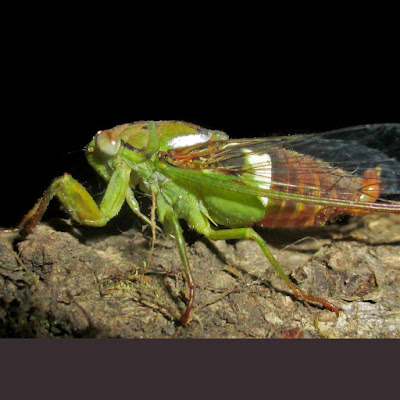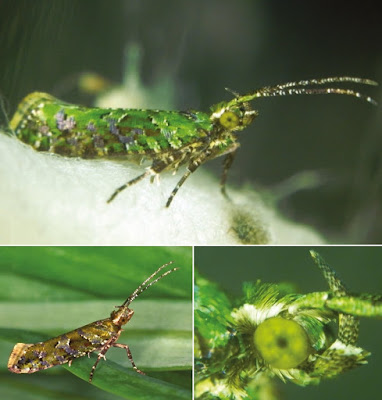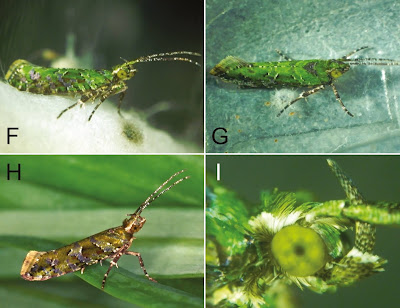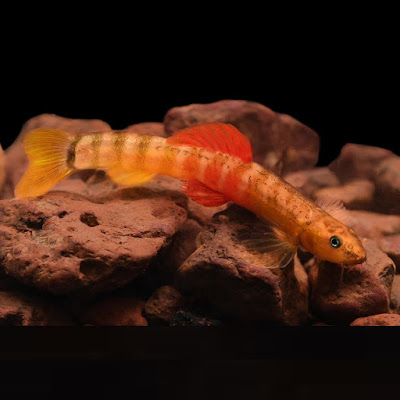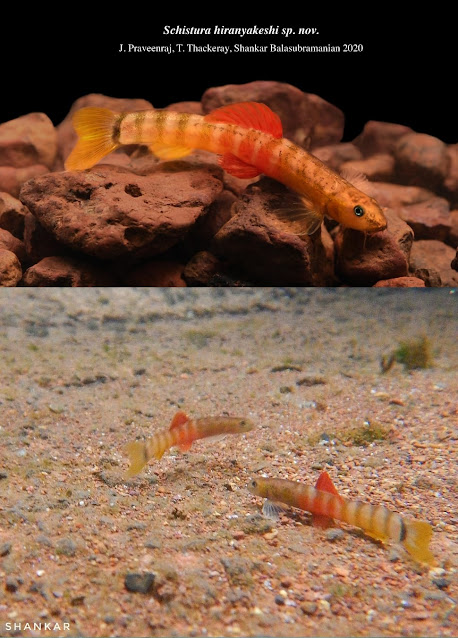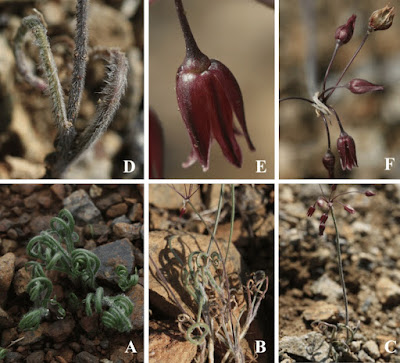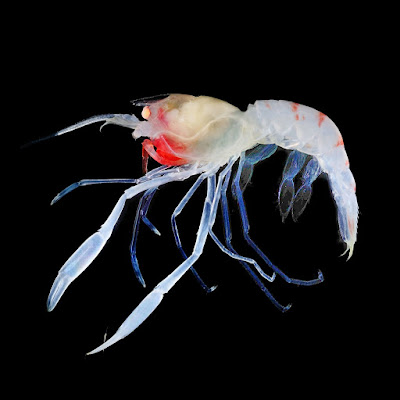[Most Recent Entries] [Calendar View]
Monday, January 25th, 2021
| Time | Event | ||||
| 2:01a | [Entomology • 2021] Three New Species of the Genus Mata Distant, 1906 (Hemiptera: Cicadidae: Cicadinae: Oncotympanini) with Notes on Their Natural History from Meghalaya, India
Abstract Three new species of the Asian genus Mata Distant, 1906 (Hemiptera: Cicadidae) viz. Mata lenonia sp.nov.; Mata ruffordii sp.nov. and Mata meghalayana sp.nov. are described from Indian state of Meghalaya. Keys and taxonomic descriptions of these species are provided with detailed accounts of their natural history and acoustics. Keywords: Hemiptera, Indo-Burma Biodiversity Hotspot, Cicada, Mata, Species Discovery, Natural History, Meghalaya Mata lenonia Vivek Sarkar, Cuckoo Mahapatra, Pratyush P. Mohapatra, Manoj V. Nair and Krushnamegh Kunte. 2021. Description of Three New Species of the Genus Mata Distant, 1906 (Hemiptera: Cicadidae: Cicadinae: Oncotympanini) with Notes on Their Natural History from Indian State of Meghalaya, India. Zootaxa. 4908(1); 1–28. DOI: 10.11646/zootaxa.4908.1.1 | ||||
| 2:15a | [Entomology • 2020] Beyond Wallace: A New Lineage of Chrysorthenches (Lepidoptera: Yponomeutoidea: Glyphipterigidae) reveals A Journey Tracking Its Host-plants, Podocarpus (Pinopsida: Podocarpaceae)
Abstract A northward trans-Wallacean radiation is demonstrated for Chrysorthenches, a member of the Orthenches group. Here we review Chrysorthenches and allied genera resulting in a generic transfer of Diathryptica callibrya to Chrysorthenches and two new congeners: C. muraseae Sohn & Kobayashi sp. nov. from Japan and C. smaragdina Sohnsp. nov. from Thailand. We review morphological characters of Chrysorthenches and allied genera, and find polyphyly of Diathryptica and the association of the Orthenches-group with Glyphipterigidae. These findings were supported in a maximum likelihood phylogeny of DNA barcodes from ten yponomeutoids. We analysed 30 morphological characters for 12 species of Chrysorthenches, plus one outgroup, via a cladistic approach. The resulting cladogram redefined two pre-existing Chrysorthenches species-groups and identified one novel lineage: the C. callibrya species-group. We review the host associations between Chrysorthenches and Podocarpaceae, based on mapping the working phylogenies. Our review suggests that ancestral Chrysorthenches colonized Podocarpus and later shifted to other podocarp genera. Biogeographical patterns of Chrysorthenches show that they evolved long after the Podocarpaceae radiation. Disjunctive trans-Wallacean distribution of the C. callibrya species-group is possibly related to the tracking of their host-plants and the complicated geological history of the island-arc system connecting Australia and East Asia. Keywords: Gondwana, Lepidoptera, phylogenetics, plant/insect interaction, taxonomy, Wallace’s Line Superfamily Yponomeutoidea Stephens, 1829 Famly Glyphipterigidae Stainton, 1854 Genus Chrysorthenches Dugale, 1996 Chrysorthenches Dugdale, 1996: 34. Type species: Orthenches porphyritis Meyrick, 1886, by original designation. Chrysorthenches callibrya (Turner, 1923), comb. nov. Distribution: Australia (New South Wales, Queensland). Host-plants: Possibly Podocarpus lawrencei Hook.f., Podocarpaceae (adult association).
Chrysorthenches muraseae Sohn & Kobayashi, sp. nov. Etymology: The species epithet is dedicated to Ms Masumi Murase, who provided valuable information, collected specimens of this species and donated them to us. Distribution: Japan (Honshu, Shikoku). Host-plants: Podocarpus macrophyllus (Thunb.) Sweet., Podocarpaceae. Chrysorthenches smaragdina Sohn, sp. nov. Distribution: Thailand. Etymology: The epithet is derived from the Greek σμαράγδι, ‘smarágdi’, Chrysorthenches muraseae , referring to the broad green patch on the forewing of this new species. Jae-Cheon Sohn, Shigeki Kobayashi and Yutaka Yoshiyasu. 2020. Beyond Wallace: A New Lineage of Chrysorthenches (Lepidoptera: Yponomeutoidea: Glyphipterigidae) reveals A Journey Tracking Its Host-plants, Podocarpus (Pinopsida: Podocarpaceae). Zoological Journal of the Linnean Society. 190(2); 709–736. DOI: 10.1093/zoolinnean/zlaa009 | ||||
| 2:22a | [Ichthyology • 2020] Schistura hiranyakeshi • A New Loach (Cypriniformes: Nemacheilidae) from Maharashtra, Northern Western Ghats, India
Schistura hiranyakeshi, a new species of loach is described from Hiranyakeshi River, Amboli, Sindhudurg district, Maharashtra. It is unique among congeners from peninsular, northeastern, and central India, and Sri Lanka in having an incomplete lateral line with 6-7 pores and ending at a point vertical at half the length of the adpressed pectoral fin; dorsal fin and caudal fin devoid of spots or blotches; body with 9-10 bars that are wider or almost equal in width to the interspaces; dorsal fin, anal fin and sub-dorsal bars with a unique crimson color in adult males; lower lip with a black mark on each side of the median interruption in live and preserved specimens; and no suborbital flap or axillary pelvic lobe. Schistura hiranyakeshi named after the Hiranyakeshi River drainage in Sindhudurg District of Maharashtra, India, where type locality (a temple pond fed by a natural spring from a laterite cave system) is situated; also, in Sanskrit, hiranyakeshi means “golden hair,” alluding to the golden-yellow coloration and body of adult specimens Jayasimhan Praveenraj, Tejas Thackeray and Shankar Balasubramanian. 2020. Schistura hiranyakeshi A New Loach (Cypriniformes: Nemacheilidae) from Maharashtra, Northern Western Ghats, India. aqua - Int. Journal Ichthyol. 26(2) | ||||
| 2:22a | [Botany • 2020] Allium shahinii (Amaryllidaceae) • A New Species of Allium sect. Scorodon from Eastern Turkey
Abstract Allium shahinii, a new species of Allium sect. Scorodon, is described and illustrated from Erzincan Province, Eastern Turkey. It is a narrowly distributed geophyte growing on siliceous screes of warm exposure in mountain ranges of the nemoral and thermophilous deciduous woodland zone, showing close morphological relationships mainly with A. moschatum, A. stocksianum, A. spirophyllum, A. circumflexum but it is clearly differentiated due to perigon, outer tunic, indumentum, leaf and scape characteristics. In this study, diagnostic characters, description, taxonomic comments, photographs, distribution map, detailed illustration, the conservation status of A. shahinii and identification key are provided for A. shahinii and related taxa. According to IUCN Red List Categories and Criteria, A. shahinii is assessed here as a Critically Endangered (CR) species. Keywords: A. moschatum, A. stocksianum, A. spirophyllum, A. circumflexum, morphology, taxonomy, Turkey, Monocots Gülnur Ekşi and Hayri Duman. 2020. Allium shahinii: A New Species of A. sect. Scorodon (Amaryllidaceae) from Turkey. Phytotaxa. 461(3); 195–203. DOI: 10.11646/phytotaxa.461.3.6 | ||||
| 4:00a | [Crustacea • 2021] First Record of the Rare Stenopodidean Shrimp Odontozona spongicola (Alcock & Anderson, 1899) (Decapoda: Stenopodidea: Stenopodidae) from Indonesia
Abstract The stenopodidean shrimp Odontozona spongicola (Alcock & Anderson, 1899) collected by the South Java Deep-Sea Biodiversity Expedition 2018 (SJADES 2018) is a new record from Indonesia. The specimen of O. spongicola recently listed from the South China Sea is also formally reported here in. The characteristcs and coloration of this rare species are described and illustrated. Keywords: Crustacea, Deep-sea, Odontozona, new record, Indonesia, South China Sea Odontozona spongicola (Alcock & Anderson, 1899) Chien-Lin Chen and Tin-Yam Chan. 2021. First Record of the Rare Stenopodidean Shrimp Odontozona spongicola (Alcock & Anderson, 1899) (Decapoda: Stenopodidea: Stenopodidae) from Indonesia. Zootaxa. 4915(4); 575–584. DOI: 10.11646/zootaxa.4915.4.8 | ||||
| 11:16a | [Paleontology • 2021] Karutia fortunata • A New Reptile from the lower Permian of Brazil and the Interrelationships of Parareptilia
Abstract A new parareptile from the Cisuralian Pedra de Fogo Formation of north-eastern Brazil is described. Karutia fortunata gen. et sp. nov. is the first Gondwanan member of Acleistorhinidae, a clade previously known only from North America but thought to be closely related to the Russian Lanthanosuchidae. A re-examination of parareptile phylogeny indicates that lanthanosuchids are not closely related to acleistorhinids. These results are more congruent both stratigraphically and biogeographically than the previous ‘lanthanosuchoid’ position for acleistorhinids, as they eliminate a 15 Ma ghost lineage within parareptiles, leaving Acleistorhinidae as an exclusively Pennsylvanian/Cisuralian clade from western Pangaea. Karutia fortunata contributes to our knowledge of the early Permian diversity of Parareptilia in Gondwana, a clade previously represented only by the mesosaurid inhabitants of the Irati-Whitehill epicontinental sea in the southern portion of the supercontinent. The new parareptile joins captorhinids in the amniote record of the Pedra de Fogo Formation, improving our picture of the inland tetrapod fauna of the southern hemisphere during the Cisuralian. Keywords: Reptilia, Parareptilia, Acleistorhinidae, Gondwana, Cisuralian, Pedra de Fogo Formation, Parnaíba Basin 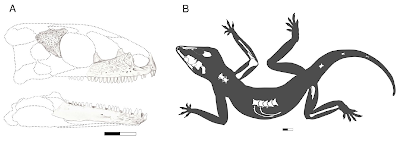 Karutia fortunata gen. et sp. nov. Juan Carlos Cisneros, Christian F. Kammerer, Kenneth D. Angielczyk, Jörg Fröbisch, Claudia Marsicano, Roger M. H. Smith and Martha Richter. 2021. A New Reptile from the lower Permian of Brazil (Karutia fortunata gen. et sp. nov.) and the Interrelationships of Parareptilia. Journal of Systematic Palaeontology. DOI: 10.1080/14772019.2020.1863487 |
| << Previous Day |
2021/01/25 [Calendar] |
Next Day >> |
